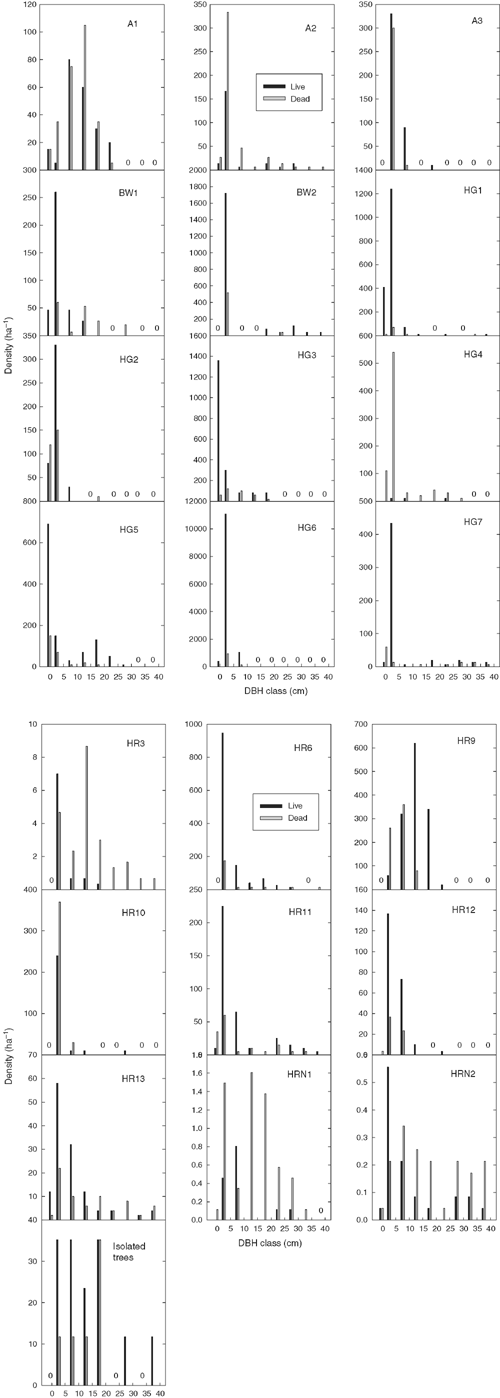What limits the distribution and abundance of the native conifer Callitris glaucophylla (Cupressaceae) in the West MacDonnell Ranges, central Australia?
Lynda D. Prior A C , Zoe Lee A , Chris Brock B , Grant J. Williamson A and David M. J. S. Bowman AA School of Plant Science, University of Tasmania, Private Bag 55, Hobart, Tas. 7001, Australia.
B Parks and Wildlife Service of the Northern Territory, PO Box 2130, Alice Springs, NT 0871, Australia.
C Corresponding author. Email: lynda.prior@utas.edu.au
Australian Journal of Botany 58(7) 554-564 https://doi.org/10.1071/BT10045
Submitted: 17 February 2010 Accepted: 4 September 2010 Published: 27 October 2010
Abstract
The conifer Callitris glaucophylla J.Thompson & L.A.S.Johnson (Cupressaceae) is a fire-sensitive obligate seeder with a heavily fragmented distribution across the Australian continent. We undertook a broad-scale biophysical survey and analysed the population structure of 21 populations in the West MacDonnell Ranges of central Australia. C. glaucophylla had a patchy distribution associated with steep, rocky metamorphic areas with limited evidence of fire. Variation in population structures was clearly related to recent fire history. Nearly half of ‘adult’ C. glaucophylla trees (>5-cm stem diameter) from the sampled stands were dead, with the proportion at individual sites related to evidence of fire. Fire scars were evident on 48% of all live trees we measured. The overall density of live adult trees conformed to a negative exponential size-class distribution, consistent with a regionally stable population structure. However, we found higher sapling densities and lower seedlings densities than expected by this distribution. This regional peak in the sapling size class reflects a pulse of recruitment, possibly associated with a wet period in the 1970s. Low seedling densities are probably due to subsequent drought. We conclude that fire controls the distribution of Callitris on the West MacDonnell Ranges, and the timing of recruitment depends on rainfall patterns.
Acknowledgements
We thank staff of the Parks and Wildlife Service of the Northern Territory for logistical support, especially Chris Day, Mark Trower and Dan Adams. We also thank Janelle Dennis, Sophie Edwards and Stephen Lee for field assistance. This work was partly funded by CERF Grant B0016193.
Auld AD, Keith DA
(2009) Dealing with threats: integrating science and management. Ecological Management & Restoration 10, S79–S87.
| Crossref | GoogleScholarGoogle Scholar |
[verified September 2010]
Clarke PJ,
Latz PK, Albrecht DE
(2005) Long-term changes in semi-arid vegetation: invasion of an exotic perennial grass has larger effects than rainfall variability. Journal of Vegetation Science 16, 237–248.
| Crossref | GoogleScholarGoogle Scholar |
[verified September 2010]
Prior LD,
Eamus D, Bowman DMJS
(2004) Tree growth rates in north Australian savanna habitats: seasonal patterns and correlations with leaf attributes. Australian Journal of Botany 52, 303–314.
| Crossref | GoogleScholarGoogle Scholar |
[verified September 2010]
Read J
(1995) Recruitment characteristics of the white cypress pine (Callitris glaucophylla) in arid South Australia. The Rangeland Journal 17, 228–240.
| Crossref | GoogleScholarGoogle Scholar |
[verified September 2010]
Zimmer WS
(1944) Notes on the regeneration of Murray pine (Callitris spp.). Transactions of the Royal Society of South Australia 68, 183–190.


|



